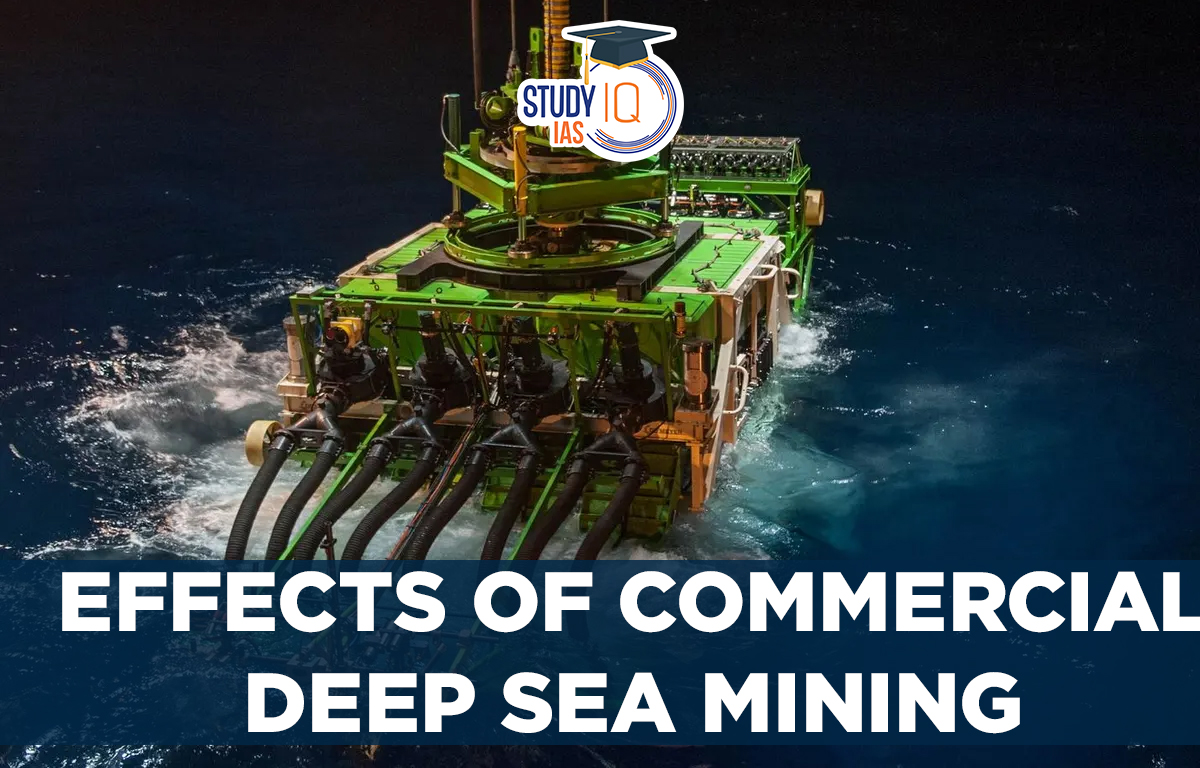Table of Contents
Context: A recent study published in journal Frontiers in Marine Science has observed that deep seabed mining operations could present serious risks to ocean ecosystems.
What are the Effects of Commercial Deep Sea Mining According to the Study?
- Noise pollution: If allowed, commercial-scale mining is expected to operate 24 hours a day, causing noise pollution.
- The mining noise can overlap with the frequencies at which cetaceans communicate, which can cause auditory masking and behaviour change in marine mammals, the analysis said.
- Sediment plumes: Deep-sea mining will stir up fine sediments on the seafloor consisting of silt, clay and the remains of microorganisms, creating plumes of suspended particles.
- Settlement of sediment plumes generated by mining vehicles could smother the species at the bottom of the ocean, or benthic species, in the vicinity.
- Habitat destruction: Deep sea mining operations can physically disturb seafloor habitats, destroying or altering critical habitats for deep sea species, including corals, sponges, and other organisms.
- Disruption of deep sea carbon storage: The deep sea plays an important role in storing carbon, and mining activities could potentially disrupt this process, releasing large amounts of carbon into the atmosphere and contributing to climate change.
About Deep Sea and Deep Sea Mining
- The deep sea is broadly defined as the ocean depth where light begins to fade, at an approximate depth of 200 metres or the point of transition from continental shelves to continental slopes.
- Features of deep sea:
- The deep sea is characterized by extremely high pressure, low temperatures, and darkness.
- Some of the notable features of the deep sea include underwater mountains and ridges, vast plains and canyons, hydrothermal vents, and cold seeps.
- Deep sea minerals: They are minerals that are found in the ocean floor, specifically in the deeper parts of the ocean, beyond the continental shelf.
- Polymetallic nodules: These are small, rounded lumps of minerals that are found on the seafloor, usually on abyssal plains. They are composed of manganese, iron, nickel, copper, and cobalt.
- Seafloor massive sulfides (SMS): They form around hydrothermal vents, where hot, mineral-rich fluids are released from the seafloor. SMS deposits are composed of copper, gold, silver, zinc, and other metals.
- Cobalt-rich crusts: They form on the seafloor, typically on seamounts and other volcanic features. They are composed of cobalt, nickel, iron, manganese, and other metals.

- Need for deep sea minerals: Depleting terrestrial deposits and rising demand for metals are stimulating interest in the deep sea, with focus on commercial mining.
- Who authorizes deep sea mining? The International Seabed Authority (ISA) is responsible for organizing, regulating, and controlling all mineral-related activities in the international seabed area beyond the limits of national jurisdiction.
- ISA is an intergovernmental organization that was established by the United Nations Convention on the Law of the Sea (UNCLOS) in 1994.
- Till May 2022, ISA had issued 31 contracts to explore deep-sea mineral deposits.

India’s Quest Towards Deep Sea
- Deep ocean mission: In 2021, the Union Cabinet has approved the ‘deep ocean mission’ with an outlay of Rs. 4077 crores for a period of 5 years.
- In the Union Budget 2023-24, the government has further allocated Rs 600 crore for the deep ocean mission.
- India and Polymetallic Nodules:
- India had signed a 15-year contract for exploration of Polymetallic Nodules in Central Indian Ocean Basin (CIOB) with the International Seabed Authority in 2002.
- In 2016, India got an extension of this contract up to 2022.
- Samudrayaan Mission: It is India’s first unique manned ocean mission that aims to send men into the deep sea in a submersible vehicle for deep-ocean exploration and mining of rare minerals.
- It will send three persons in a manned submersible vehicle MATSYA 6000 to a depth of 6000 metres into the sea for deep underwater studies.
- With this Unique Ocean Mission, India joined the elite club of nations such as the US, Russia, France, Japan, and China to have niche technology and vehicles to carry out subsea activities.


 Question Hour in Parliament: Meaning, Ty...
Question Hour in Parliament: Meaning, Ty...
 Daily Quiz 18 July 2025
Daily Quiz 18 July 2025





















